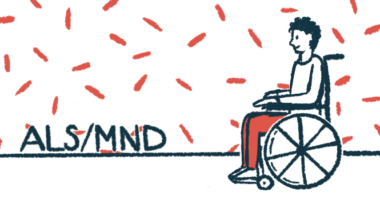Vocal Cord Spasms in ALS May Be Triggered by Excessive Saliva

Although not thought common, laryngospasm — the sudden contraction of the vocal cords that makes speaking and breathing temporarily difficult — does affect some with amyotrophic lateral sclerosis (ALS), a study reported.
Excess saliva irritating the vocal cords was the most notable trigger for laryngospasm in their work, the researchers noted, which may be associated with injury to the nerves responsible for swallowing and speaking.
The study, “Laryngospasm in Amyotrophic Lateral Sclerosis,” was published in the journal Muscle & Nerve.
In ALS patients, the corticobulbar tract — a pathway that carries information from the brain to the muscles of the face, head, and neck — progressively deteriorates, as do the nerves controlling throat and tongue muscles. This type of neuronal degeneration, called bulbar dysfunction, generally causes symptoms such as dysarthria (slowed or slurred speech), dysphonia (hoarseness), and dysphagia (swallowing difficulties).
Laryngospasm has been reported in people with ALS, with gastric reflux and smoking identified as its main risk factors. Whether this symptom is common in ALS and how it is triggered, however, has not been described.
Researchers in Canada reviewed the medical records of 571 patients being treated at the Ottawa Hospital ALS Clinic between January 2008 and December 2018.
They searched for words in patient files such as “laryngospasm,” and for phrases including “throat spasm,” “stridor” (noisy breathing), and “airway closure.” A neuromuscular neurologist and speech language pathologist then reviewed the retrieved records to confirm a diagnosis of laryngospasm.
Of these 571 patients, 23 (4%) had laryngospasm. Their mean age was 63.4 and over half (57%) were women.
Bulbar dysfunction was assessed by the bulbar subscores of the ALS functional rating scale, which measure a patient’s speech, swallowing and salivation. Lower subscores, on a scale from zero to 12, indicate greater dysfunction. Most of these 23 patients with laryngospasm had subscores ranging seven to 10, indicating moderate bulbar impairment.
“These findings support the hypothesis that laryngospasm occurs simultaneously with bulbar dysfunction,” the scientists wrote.
Only 26% of them were cigarette smokers, however, and 13% had previously reported gastric reflux.
“Many patients were unable to identify a trigger for laryngospasm,” the study noted. Patients described laryngospasm as a sensation of choking, tickling, throat closure, and difficulty breathing.
They also mentioned “triggering circumstances” that ranged from excessive saliva irritating the vocal cords (35%), eating a meal (17%), speaking (9%), taking a lung function test or using cough assist devices (9%), to humidity (4%) and reflux (4%).
“The most important trigger for laryngospasm was excess saliva, again potentially relating to the intimate link between bulbar dysfunction and laryngospasm in ALS,” the researchers wrote.
The number of laryngospasm episodes were variable, with some patients reporting a single event and one noting repeat attacks, sometimes five times per hour. A majority of patients (57%) didn’t address how they handled a laryngospasm; those who did mentioned coping mechanisms such as drinking water (13%), using breathing techniques (9%), and taking medications like the muscle relaxer baclofen (9%), and lorazepam (4%), an anxiety treatment.
Laryngospasm induced anxiety in almost half of these 23 people.
“In summary, this study found that laryngospasm was most closely related to moderate bulbar dysfunction. We believe clinicians should have a higher index of suspicion for laryngospasm as ALS patients begin to experience symptoms of dysarthria, dysphonia, or dysphagia,” the researchers wrote.
They noted that further studies are needed to accurately determine the prevalence of laryngospasm in ALS, its characteristics, and its triggers. Treatments for laryngospasm should also be investigated, the team added.







